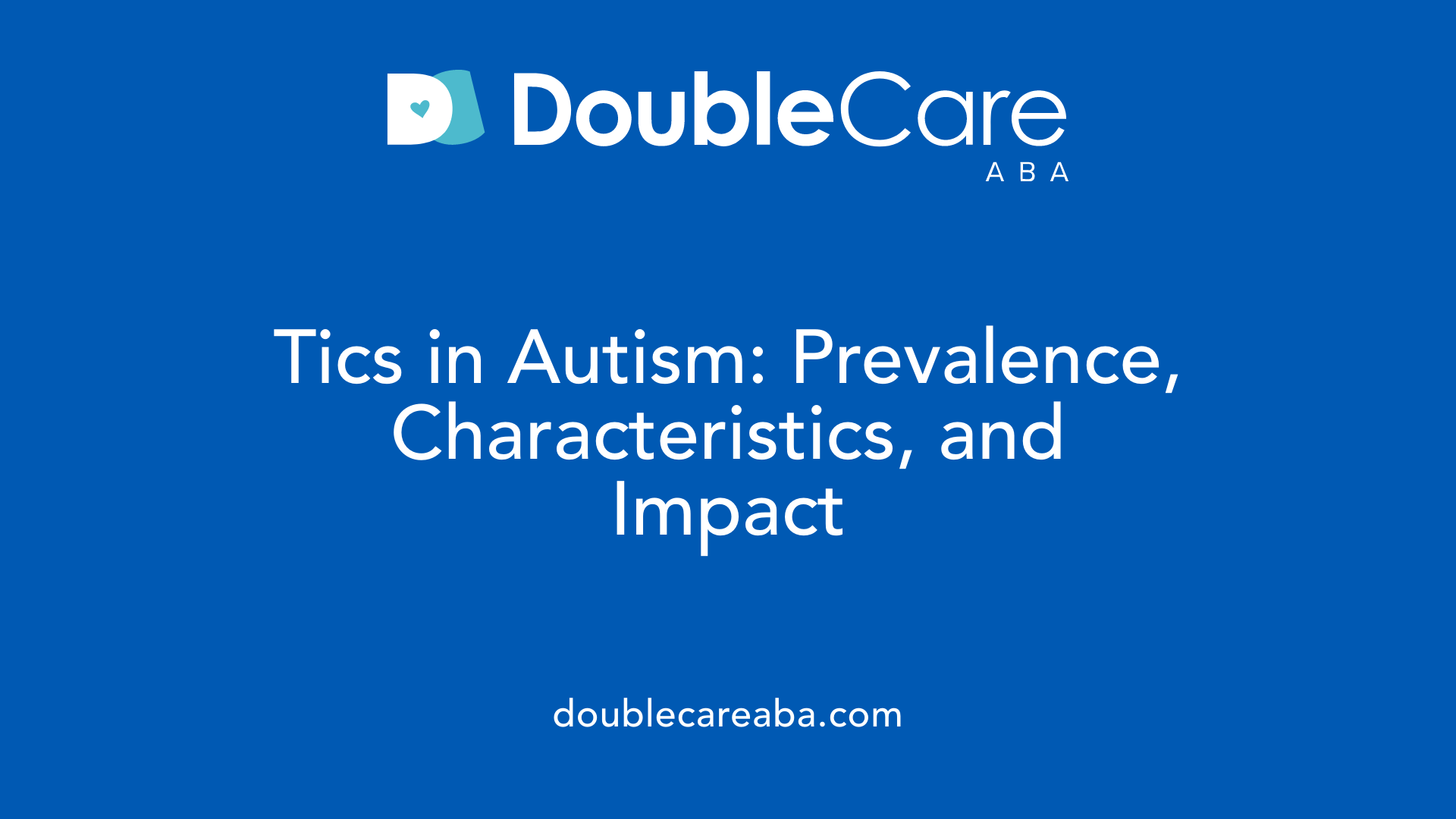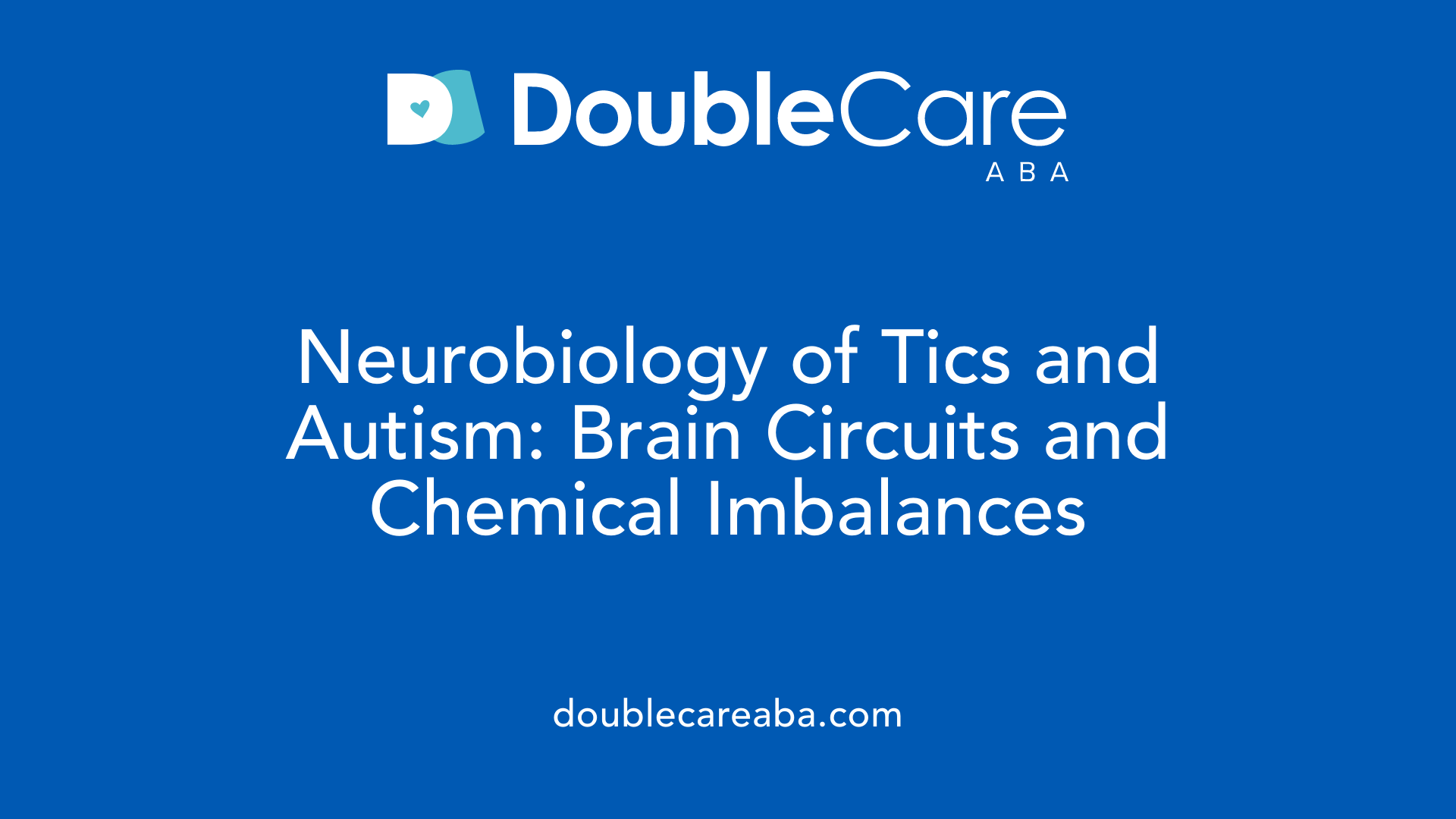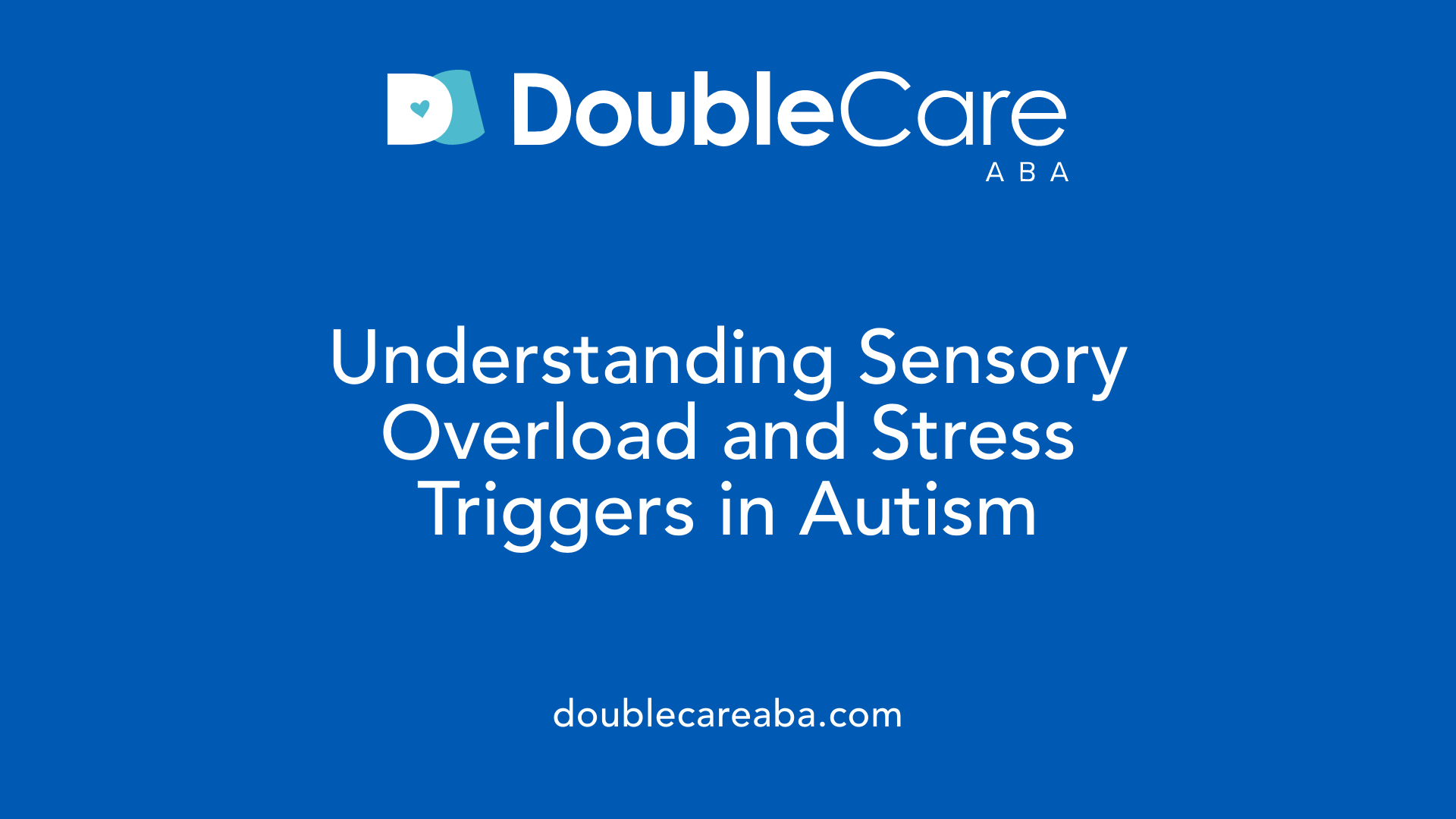An In-Depth Exploration of Co-Occurring Conditions
Autism spectrum disorder (ASD) and tic disorders frequently intersect, creating complex clinical profiles that pose challenges and opportunities for effective management. This article delves into the connection between autism and tics, characteristics, diagnosis, treatment options, and the neurobiological mechanisms involved, providing a comprehensive overview to inform clinicians, educators, and caregivers.
The Prevalence and Nature of Tics in Individuals with Autism

What is the relationship between autism and tic disorders?
Autism spectrum disorder (ASD) frequently co-occurs with tic disorders, including Tourette syndrome (TS). Estimated prevalence rates for tics in individuals with autism range from 9% to 12%, with some studies suggesting higher rates among high-functioning populations. Many individuals with ASD exhibit motor tics such as blinking, head jerking, or hand flapping, as well as vocal tics like throat clearing, grunting, or echolalia.
Research indicates that people with both ASD and tics tend to have higher IQ scores and experience more significant social and behavioral challenges than those with ASD alone. The underlying neurological factors common to both conditions involve shared brain regions, including the basal ganglia, thalamus, and frontal cortex, along with neurotransmitter imbalances, especially in dopamine pathways.
Recognizing the differences between tics and stereotypies—repetitive, rhythmic behaviors used for self-soothing—is important for effective management. Tics are involuntary and often preceded by premonitory urges, whereas stereotypies are purposeful and voluntary. Proper diagnosis enables tailored behavioral interventions and, when necessary, medication to help manage symptoms.
What are the characteristics and symptoms of tics in individuals with autism?
Tics manifest as sudden, brief, involuntary movements or sounds. Common motor tics in individuals with autism include eye blinking, facial grimacing, shoulder shrugging, head jerking, and finger tapping. Vocal tics can involve throat clearing, grunting, repeating words or sounds, or even shouting. These behaviors may be simple, involving single muscle groups or sounds, or complex, combining multiple movements or vocalizations.
Typically, tics appear around age six but can begin earlier or later, sometimes following a period of increased stress or sensory overload. Many individuals report experiencing sensations such as tenseness or energy buildup prior to executing a tic. Performing the tic then provides temporary relief.
Tics tend to fluctuate over time, often worsening with stress, excitement, or fatigue, and improving during restful or calming moments. They are distinct from stereotypies, which are rhythmic and purposeful behaviors like rocking or flapping, usually serving as self-regulation mechanisms. Support strategies include behavioral therapies like Habit Reversal Training (HRT), creating calming environments, and explaining tics to the individual to foster acceptance.
In some cases, if tics are severe or cause distress, clinicians may consider medication options, but behavioral management remains the primary approach. Understanding tics’ neurobiological basis and their relation to other neurodevelopmental disorders helps inform comprehensive care plans.
Neurobiological Mechanisms Underpinning Autism and Tics

What potential causes and underlying mechanisms of tics in autistic individuals?
The origins of tics in those with autism are rooted in complex neurobiological processes involving multiple brain regions and neurotransmitter systems. Key structures such as the basal ganglia, thalamus, and cortical areas play crucial roles in motor control, behavioral regulation, and sensory processing.
Research indicates that in autism and related tic disorders, these areas often show signs of under-activation or dysregulation. For example, neuroimaging studies reveal that certain parts of the basal ganglia, which normally help inhibit involuntary movements, are less active. This leads to a state of disinhibition, allowing unwanted motor and vocal responses, or tics, to occur more readily.
These mechanisms are further supported by evidence of imbalance in brain chemicals, particularly dopamine and serotonin. Elevated dopamine activity has been strongly associated with the development of tics, especially motor tics, because dopamine influences the functioning of the basal ganglia. When dopamine levels are too high or not properly regulated, the suppression of involuntary movements becomes compromised.
Serotonin dysregulation also contributes to these behaviors. Both neurotransmitters are involved in modulating mood, impulse control, and motor activity, and disruptions in their balance can exacerbate tics.
Moreover, neural pathways related to disinhibition and sensory processing are involved. Disinhibition refers to the reduced ability of the brain's filtering systems to suppress irrelevant or unwanted actions, which can result in the emergence of tics. Sensory sensitivities common in autism may also trigger or worsen these involuntary movements, creating a cycle of sensory overload and motor responses.
In summary, the neurobiological basis of tics in autistic individuals involves a complex interaction between specific brain structures and neurotransmitter systems. Imbalances in dopamine and serotonin, combined with dysfunction in neural circuits responsible for inhibition and sensory integration, establish a pathway that fosters the emergence of involuntary tic behaviors.
Research findings on neural activity and brain activation patterns
Recent studies utilizing functional MRI (fMRI) and other neuroimaging technologies have demonstrated key findings regarding brain activity in autism and tic disorders. These include:
- Under-activation in the basal ganglia correlates with increased tic severity.
- Disrupted connectivity between cortical and subcortical regions may impair motor and behavioral regulation.
- Altered activity in the thalamus and frontal cortex has been observed in individuals with tics, supporting the involvement of motor and executive control pathways.
- Patterns of brain activity often show increased activity in areas linked to sensory processing, which could relate to the sensory sensitivities that often accompany autistic traits.
These findings help solidify the concept that tics in autism originate from shared neurobiological pathways with other tic disorders, emphasizing the importance of targeting these brain circuits in future therapeutic approaches.
Differentiating Tics from Stereotypies and Other Repetitive Behaviors

How are tics differentiated from stimming and other repetitive behaviors in autism?
Tics and stereotypic behaviors, or stimming, are both common in autism but serve different functions and have distinct characteristics.
Tics are sudden, involuntary movements or sounds that occur rapidly and are often brief. They include actions such as eye blinking, throat clearing, head jerking, or facial grimacing. Tics are driven by internal neurological urges, which may be preceded by sensations known as premonitory urges. These urges often build until the tic is performed, providing temporary relief. Tics tend to be unpredictable, less controllable, and can wax and wane over time.
In contrast, stimming behaviors are typically self-initiated and purposeful. They are often rhythmic and sustained, serving functions such as self-regulation, expressing excitement, or managing sensory overload. Examples include hand-flapping, rocking, or humming.
The primary difference between these behaviors lies in their purpose and level of control. While tics are involuntary and less within voluntary control, stimming is generally voluntary, allowing individuals to modulate or suppress it to some extent.
Understanding this distinction is essential for providing appropriate support. Recognizing that tics stem from neurological urges can help in developing management strategies, whereas supporting self-regulation through stimming involves respecting these self-initiated behaviors.
Clinicians and caregivers should pay careful attention to the nature, context, and triggers of these behaviors. For example, tics may increase during stress or fatigue and are often associated with sensations that prompt the tic, while stimming may be used intentionally to soothe or focus.
Overall, differentiating between tics and stimming facilitates accurate diagnosis, helps tailor interventions, and promotes better understanding and acceptance of individual behaviors in autism.
| Behavior Type | Characteristics | Purpose | Control | Typical Triggers |
|---|---|---|---|---|
| Tics | Sudden, brief, involuntary movements or sounds | Neurological urges; relief of premonitory urges | Less voluntary; difficult to suppress | Stress, fatigue, excitement |
| Stimming | Rhythmic, sustained, purposeful movements or sounds | Self-regulation; emotional expression; sensory management | Voluntary; can be initiated, altered, or suppressed | Excitement, sensory overload, boredom |
Recognizing these differences fosters empathy and supports the development of personalized behavioral strategies.
Clinical Features and Impact of Tics in Autism
What is the prevalence of tics in individuals with autism, and what are the clinical features?
The occurrence of tics in those with autism spectrum disorder (ASD) has been widely studied, revealing a range of prevalence rates depending on the sample size, assessment methods, and diagnostic criteria used. Large population-based studies estimate that approximately 4.8% of individuals with ASD also meet criteria for Tourette syndrome, while other studies report that between 6.48% and 11% of autistic children and adolescents experience tic disorders. On a broader level, the overall co-occurrence of any tic disorder in ASD ranges from 9% to 12%, indicating that tics are relatively common among this population.
Clinically, tics in individuals with ASD typically involve both motor and vocal components. Motor tics may include blinking, head jerking, shoulder shrugging, finger tapping, and facial grimacing. Vocal tics can manifest as throat clearing, grunting, humming, echolalia (repeating others’ words), and sometimes involuntary shouting or utterances. These behaviors tend to be rapid, repetitive, and involuntary, often fluctuating in intensity and frequency over time.
The onset of tics usually occurs in early childhood, generally between ages 3 to 8 years. They tend to wax and wane, with periods of exacerbation and remission, often influenced by factors such as stress, tiredness, and sensory overload. Interestingly, motor tics often decrease during or after puberty, although vocal tics may persist longer.
Differentiating tics from stereotypies (rhythmic, purposeful behaviors) and other ASD-related behaviors can be challenging because they sometimes resemble each other. For example, repetitive hand movements might be tics or self-soothing behaviors like hand-flapping. Accurate identification requires careful observation and assessment by healthcare professionals.
The clinical features of tics overlap with and sometimes mimic other behaviors seen in autism, such as echolalia and repetitive motor movements, complicating diagnosis. Moreover, neurobiological studies suggest that tics and ASD share common pathways involving abnormal activity in brain regions like the basal ganglia, thalamus, and frontal cortex.
Typical age of tic onset and progression
Motor tics usually appear between ages 3 and 8, with their severity varying over time. They often peak during early adolescence and tend to improve in late adolescence or adulthood for many individuals.
Severity and fluctuation of symptoms
The severity of tics can range from mild to severe, sometimes causing physical discomfort or social embarrassment. Tics often fluctuate, increasing under stress or fatigue and decreasing during calm or relaxing states.
Impact on daily functioning and social interactions
Tics can interfere with daily functioning, especially if they are severe or conspicuous. For children, ongoing tics might lead to teasing or social isolation, impacting self-esteem. They can also cause physical discomfort, such as muscle strain or injury from persistent movements. In school settings, tics might distract the individual or hinder concentration. While many individuals manage their tics effectively, persistent or severe tics can reduce quality of life and contribute to emotional distress.
Comorbidities commonly associated (OCD, ADHD, anxiety)
Tic disorders frequently co-occur with other neurodevelopmental conditions. Obsessive-compulsive disorder (OCD) is commonly associated, with some symptoms overlapping, such as compulsive behaviors and intrusive thoughts. Attention-deficit/hyperactivity disorder (ADHD) is also prevalent among those with tics, contributing to impulsivity and inattentiveness. Anxiety disorders are common triggers for tic exacerbation; stress and sensory sensitivities exacerbate tics and related behaviors. Studies show that individuals with both ASD and tics tend to have higher scores on measures of social impairment, emotional problems, and compulsivity compared to those with ASD alone. Specifically, higher scores on tools like the Social Responsiveness Scale-2 (SRS-2), Child Behavior Checklists (CBCL), and Yale-Brown Obsessive–Compulsive Scale (YBOCS) indicate more severe social and behavioral difficulties. Tics may also be associated with increased sensory sensitivities, heightened anxiety, and emotional challenges, influencing overall wellbeing.
| Aspect | Details | Additional Notes |
|---|---|---|
| Prevalence | 4.8%-12% in ASD | Varies across studies and methods |
| Typical age | 3-8 years | Peak during early adolescence |
| Symptoms | Motor and vocal tics | Rapid, involuntary, fluctuating |
| Impact | Physical discomfort, social issues | Can cause teasing, self-esteem concerns |
| Comorbidities | OCD, ADHD, anxiety | Elevate overall behavioral challenges |
Management and Therapeutic Approaches for Tics in Autism
What are the current treatment options and management strategies for tics in autism?
Managing tics in individuals with autism involves a combination of behavioral, medical, and supportive strategies aimed at reducing tic frequency and severity while improving overall well-being.
Behavioral therapies are the first-line treatment, especially for moderate to severe tics. Two established approaches are Habit Reversal Training (HRT) and Comprehensive Behavioral Intervention for Tics (CBIT). These therapies focus on increasing the individual's awareness of their tics and teaching them to perform a competing response that suppresses the tic when they sense an urge. These interventions have been shown to significantly decrease tic severity and are adaptable for children and adults.
Pharmacological options are considered when tics are persistent, intense, or causing significant distress. Common medications include neuroleptics like risperidone and aripiprazole, which help manage severe tics by modulating neurotransmitter activity. Alpha-2-adrenergic agonists such as clonidine and guanfacine are also frequently used; they can alleviate tics and may offer added benefits in controlling associated conditions like ADHD. Additional medications like tetrabenazine or clonazepam may be prescribed in specific cases, depending on individual response and side-effect profile.
Other medical interventions are reserved for highly resistant cases. Botulinum toxin injections can be targeted at specific muscles involved in motor tics, providing localized relief. In rare instances of severe, pervasive tics that impair functioning, deep brain stimulation (DBS) may be considered. DBS involves surgically implanting electrodes in particular brain regions to modulate neural activity, with promising results reported in select cases.
Support strategies are essential components of a comprehensive management plan. Creating a calming environment helps reduce sensory overstimulation that can trigger or worsen tics. Stress management techniques, routine scheduling, and visual supports can help individuals better cope with internal urges and external stressors.
Equally important is addressing coexisting conditions such as ADHD, OCD, or anxiety, which often exacerbate tic severity. Treating these co-occurring issues can lead to overall improvements in behavior and emotional health.
A multidisciplinary approach, involving neurologists, psychologists, occupational therapists, and educators, is optimal. Each plan should be tailored to the individual's age, tic severity, cognitive profile, and personal preferences, aiming to decrease distress and enhance daily functioning.
Below is a summary of management options:
| Treatment Modality | Examples | Purpose | Additional Details |
|---|---|---|---|
| Behavioral Therapies | CBIT, HRT | Increase awareness, teach suppression techniques | Effective for mild to moderate tics; suitable for children and adults |
| Pharmacological Treatments | Risperidone, aripiprazole, clonidine, guanfacine | Reduce tic frequency and intensity | Consider side effects and individual response |
| Medical Procedures | Botulinum toxin injections, DBS | Target specific tics or severe cases | Usually reserved for resistant, severe cases |
| Support Strategies | Calming environment, stress management | Reduce triggers, promote self-regulation | Include sensory supports and routine modifications |
In conclusion, managing tics in autism requires a comprehensive, individualized approach that combines behavioral interventions with medical and environmental strategies. Early intervention and continuous support can significantly improve quality of life for individuals affected by these symptoms.
Related Conditions and the Spectrum of Tics and Autism

Are there related conditions, such as Tourette syndrome, that are associated with autism?
Many individuals with autism spectrum disorder (ASD) also exhibit tic behaviors that resemble those seen in Tourette syndrome (TS). Research indicates that the prevalence of tics among those with ASD ranges between 9% and 12%, with some clinical studies reporting up to 22%. This overlap suggests a close relationship between the conditions.
Tourette syndrome is a neurological disorder characterized by both vocal and motor tics. While TS affects approximately 1% of the population, its co-occurrence with ASD is notable, with estimates suggesting that around 4.8% to 11% of children with ASD also meet criteria for TS. Both conditions typically emerge during childhood, with a higher prevalence among males—about 3:1 in TS and roughly 7:1 in ASD.
Shared features and differences
Tics in both ASD and TS manifest as involuntary, rapid movements or sounds, such as blinking, throat clearing, or head jerking. The phenotypic characteristics, including their distribution and repertoire, are similar across these disorders but tend to be more restricted in ASD.
Despite similarities, distinctions exist. Tics are usually brief, non-rhythmic, and can be triggered or worsened by stress, fatigue, or sensory overload. In contrast, stereotypies in autism tend to be rhythmic and more consistent. Recognizing these behaviors is essential for proper management.
Both conditions can involve sensory sensitivities that may trigger or exacerbate tics, and they often co-occur with other neurodevelopmental challenges such as ADHD and OCD. Notably, individuals with ASD who have tics tend to show higher cognitive abilities and elevated scores on social responsiveness and behavioral assessments.
Genetic and neurodevelopmental aspects
The underlying neurobiology of tics and autism shares considerable overlap. Both involve imbalances in dopamine and other neurotransmitters within key brain regions, including the basal ganglia, thalamus, and frontal cortex. These regions are crucial for movement control and executive functions.
Genetic factors play a significant role in both disorders. Family studies reveal that they often run in families, with certain gene variants linked to both ASD and tic disorders. Neuroimaging studies have identified structural similarities, such as differences in basal ganglia volume, supporting the idea of shared neurodevelopmental pathways.
The manifestation of tics in autism is believed to involve disinhibition within neural circuits, particularly in basal ganglia and related cortical areas. These neural pathways are responsible for filtering unwanted movements and behaviors, and their dysregulation leads to involuntary motor and vocal tics.
Prevalence and comorbidity rates
The co-occurrence of ASD and tic disorders varies depending on the population studied and the diagnostic criteria used. Population-based studies estimate that approximately 4.8% of children with ASD also have TS, while clinic-based investigations report rates up to 11%. Conversely, between 9% and 12% of individuals with autism display tic behaviors.
These comorbidities influence clinical presentation, educational approaches, and intervention strategies. Higher rates of tic behaviors are associated with increased severity of social impairments, obsessive-compulsive symptoms, and behavioral challenges.
Additional insights and clinical considerations
Recognizing and differentiating tics from stereotypies or deliberate behaviors is crucial for effective management. Behavioral therapies such as Habit Reversal Training (HRT) and Comprehensive Behavioral Intervention for Tics (CBIT) have shown to be effective treatments.
Medication options are typically reserved for severe cases where tics interfere significantly with daily functioning or cause distress. Common pharmacological treatments include alpha-2 adrenergic agonists and antipsychotics.
Understanding the shared and distinct features of Tics and autism informs better diagnostic accuracy and tailored interventions. Supporting individuals through education, environmental modifications, and behavioral therapy helps improve their quality of life.
| Condition | Prevalence in ASD | Typical Age of Onset | Main Features | Gender Ratio | Overlap with Tic Disorders |
|---|---|---|---|---|---|
| Autism Spectrum Disorder | 9-12%(up to 22% in some studies) | Early childhood | Social deficits, repetitive behaviors | 7:1 (male:female) | 4-5%; higher cognitive scores |
| Tourette Syndrome | ~1% | Childhood, before 18 | Motor and vocal tics | 3:1 (male:female) | About 20% of TS have ASD |
| Tic Disorders | Varies (~4.8% in ASD) | Childhood | Sudden, involuntary movements or sounds | Higher in males | Common in ASD, share neurobiology |
The Role of Sensory Sensitivities and Stress in Tics and Autism

Can autism cause twitching or similar motor behaviors?
Autism itself does not directly cause twitching or motor behaviors, but many individuals with autism experience tics—brief, involuntary movements or sounds that can resemble twitching. These tics are classified under neurodevelopmental tic disorders such as Tourette Syndrome or Persistent Tic Disorder, which often co-occur with autism.
Common autistic tics include behaviors like hand flapping, eye blinking, or vocalizations such as throat clearing. These behaviors often serve as self-stimulatory or calming actions, helping individuals manage internal sensations or sensory overload.
Tics in autism are typically preceded by a sensory urge or buildup—an internal sensation of energy or tension—that is relieved by performing the tic. They tend to fluctuate in intensity over time, especially during periods of stress, fatigue, or heightened sensory input.
While tics are involuntary and difficult to control, they are distinct from purposeful behaviors like stimming, which is voluntary and commonly used for self-regulation. Managing tics often involves behavioral strategies, environmental modifications, and, in some cases, medication.
Understanding the triggers and mechanisms behind tics in autism is vital for providing effective support, reducing distress, and improving quality of life for affected individuals.
Sensory sensitivities as triggers or exacerbators
Sensory sensitivities are a prominent feature in autism, characterized by hypersensitivity or hyposensitivity to stimuli such as lights, sounds, textures, or smells. These sensitivities can act as triggers or intensifiers for tics.
For example, overwhelming sensory environments—loud noises, bright lights, or tactile discomfort—can increase the frequency and severity of tics. The brain responds to these heightened sensory inputs with increased internal tension or stress, which may be temporarily alleviated through tic behaviors.
Sensory overload can also make individuals more aware of existing tics, causing them to become more noticeable and distressing. In some cases, sensory stimuli can induce sensory-driven tics, which are automatic responses to specific stimuli.
Strategies like creating sensory-friendly environments, using noise-canceling headphones, or providing calming sensory objects can help mitigate these triggers. Recognizing individual sensory profiles allows caregivers and professionals to tailor interventions effectively.
Stress, fatigue, and sensory overload effects
Stress and fatigue are significant factors influencing tic exacerbation in individuals with autism. When stressed, anxious, or tired, the likelihood and intensity of tics often increase.
Stress may stem from social situations, changes in routine, or sensory overload. For example, a noisy, chaotic environment can heighten internal tension, leading to more frequent or severe tics.
Sensory overload—when sensory inputs become overwhelming—can cause distress and precipitate or intensify tics. This relationship underscores the importance of managing environmental stimuli and providing predictable routines.
Tiredness also reduces the individual’s ability to self-regulate, making tics more prominent and difficult to suppress. This cycle can create a feedback loop, where increased tics lead to frustration or fatigue, further worsening tic severity.
Effective management includes ensuring adequate rest, incorporating relaxation techniques, and providing sensory breaks during demanding situations.
Implications for management and support
Understanding the influence of sensory sensitivities and stress on tics informs interventions aimed at improving daily functioning and emotional well-being.
Creating a calming environment with controlled sensory inputs can reduce the frequency of tics. This includes use of soft lighting, noise reduction, and sensory tools that help regulate arousal levels.
Educational programs for caregivers, teachers, and peers can foster awareness and patience, decreasing stigma and accidental punitive responses to involuntary behaviors.
Behavioral therapies like Habit Reversal Training (HRT) or Comprehensive Behavioral Intervention for Tics (CBIT) often incorporate sensory awareness and stress management components.
Support strategies also focus on teaching self-advocacy skills so individuals can recognize their triggers and employ coping mechanisms proactively.
In cases where tics significantly impair functioning or cause distress, medical options such as medication might be considered alongside behavioral approaches.
By emphasizing understanding and accommodation, caregivers and professionals can help individuals with autism manage tics more effectively, reducing their impact and enhancing overall quality of life.
Supporting Individuals with Autism and Tics
Understanding the complex relationship between autism and tics is essential for effective support and management. Accurate diagnosis, differentiation from stereotypies, and tailored interventions can significantly improve quality of life. Continued research into the neurobiological mechanisms and development of targeted therapies will enhance outcomes and provide hope for individuals and families navigating these co-occurring conditions.
References
- Tic Phenomenology and Tic Awareness in Adults With Autism - PMC
- Tics in Autism: Why They Happen & What to Do About Them
- Clinical characteristics of comorbid tic disorders in autism spectrum ...
- Autism and Tic Disorders - Seattle Children's Hospital
- [PDF] Differences and similarities of ASD and Tourette Syndrome
- What Are Autistic Tics? | Psych Central
- Autism and Tics: Is There a Connection?
- Autism and Tics - Golden Care Therapy














